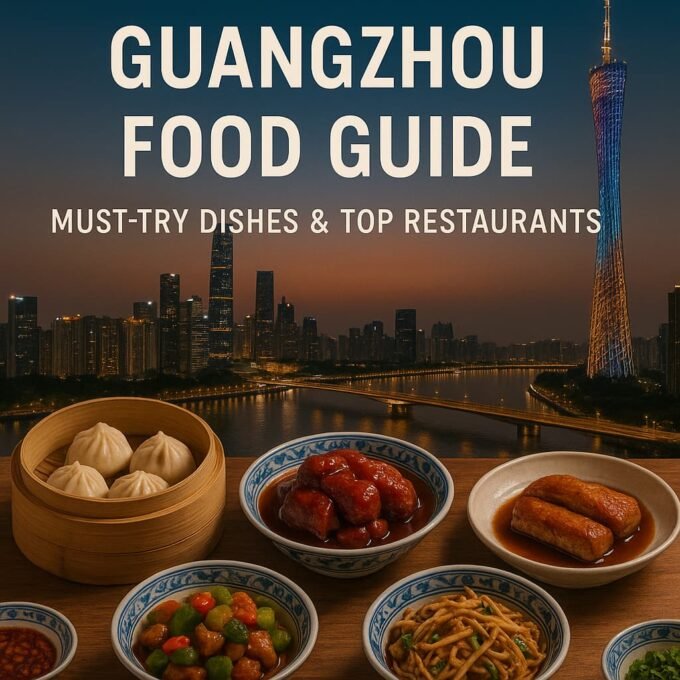Shanghai’s Food Market: A Complete Guide to Prices, Costs, and More
Discover how much does food cost in Shanghai with our comprehensive guide. Find out the latest prices and trends on our blog.

Key Highlights
- Shanghai has many types of food to enjoy, from cheap street food to fancy restaurants.
- You should plan to spend about $37 (¥268) each day on food. Street food is the cheapest choice.
- Local markets sell fresh fruits and vegetables at good prices. Supermarkets are easy but may not be as cheap.
- You can find many kinds of international food, but they can be more expensive because of imported items.
- Watch out for tourist traps. It’s often better to try local eateries for a true and budget-friendly taste of the cuisine.
Shanghai has many types of food to enjoy, from cheap street food to fancy restaurants. You should plan to spend about $37 (¥268) each day on food. Street food is the cheapest choice. Local markets sell fresh fruits and vegetables at good prices, while supermarkets offer convenience despite slightly higher rates. Many international dining options are available, though imported items may cost a bit extra. Watch out for tourist traps—local eateries often provide the best budget-friendly taste of authentic Chinese cuisine.
Shanghai is a busy city famous for its vibrant food scene. Whether you’re curious about how much is a meal in Shanghai or want to know the cost of food in Shanghai, this guide covers it all. You will learn about local markets and discover affordable eateries, while also getting tips on how to avoid tourist traps. Enjoy friendly, flavorful meals without overspending!
Understanding Shanghai’s Food Market
The food market in Shanghai has a blend of Chinese food and global flavors. Street food vendors sell many local dishes that are very tempting. Many restaurants provide various tastes, from spicy Sichuan meals to light Cantonese dim sum.
To really understand food prices, it helps to know how the market operates. There are many factors that affect prices. These include the seasons, local differences, and how popular international foods are. Let’s explore these details so you can enjoy your food journey in Shanghai.
The Impact of Seasonality on Food Prices
Seasonal changes have a big impact on the average price of food in China as well as shanghai food prices.
During busy times, like spring and autumn, there are a lot of fresh fruits and vegetables available. This usually leads to lower prices. Street food vendors adjust their prices, offering great deals during these seasons.
In winter, some ingredients may cost more because they are harder to find. However, this is often balanced by warm and filling meals that focus on seasonal foods.
Knowing how prices change with the seasons can make your meals better. Whether you like a hot bowl of noodles from a street vendor or a nice meal at a restaurant, understanding this can help you choose when and where to eat.
Regional Varieties and Their Cost Implications
Shanghai’s cuisine is well-known for its various regional styles. Each style offers unique tastes and ingredients. Shanghainese cuisine is especially recognized for its sweet and savory dishes. It is popular in the city’s food scene and is influenced by nearby places like Jiangsu and Zhejiang.
Shanghai food cost can vary widely. Dishes that include imported ingredients or special cooking methods may be priced higher. For example, a plate of hairy crabs, which are a seasonal dish from local lakes, can cost over 100 yuan.
Trying Shanghai’s local foods can make eating more fun. When you know the prices, you can enjoy tasty meals without overspending. This way, you can have a delicious and budget-friendly food journey.
Average Cost of Eating Out in Shanghai
Eating out in Shanghai remains accessible to those willing to explore eateries off the beaten tourist track.
From simple street food stalls (with food cost in Shanghai often as low as 5–15 yuan) to charming mid-range restaurants, you have plenty of options. Expect to pay around 50–100 yuan per person at mid-range spots.
keeping in mind that the average meal cost in Shanghai might vary depending on your choice between a local diner or an international restaurant.
Street Food Delights: An Affordable Choice
Shanghai’s street food snacks are a great way to enjoy delicious meals. You can find many options, like hot dumplings and yummy pancakes. The prices are really cheap, too. Most street food items cost between 5 to 15 yuan each.
Here’s a look at some tasty street food and their usual prices in Shanghai:
- Steamed Buns (Baozi): 2-5 yuan each
- Pan-fried Pork Buns (Shengjian Mantou): 8-12 yuan for four buns
- Noodles (a variety): 10-20 yuan per bowl
- Skewers (meat or vegetables): 3-5 yuan each
Eating street food lets you experience the real food culture of Shanghai. You can try many different flavors without spending much money. It’s a fun way to see all that the city offers!
Mid-range Restaurants: What to Expect
For a more comfortable dining experience, many mid-range restaurants in Shanghai offer both local and international dishes at fair prices. While these venues do not always feature shanghai restaurant prices as low as street food, they provide a unique ambience and improved quality. Whether you’re curious about the average meal price in Shanghai or simply exploring how much does a meal cost in Shanghai, these spots provide reliable standards for budgeting your meals.
Mid-range restaurants in Shanghai are a wonderful option for a better dining experience. They offer a nice selection of dishes at a fair price. You can enjoy a tasty meal without paying as much as you would in a fancy restaurant.
You should plan to spend around 50-100 yuan for each person at a mid-range restaurant, including local Chinese restaurants. A lot of these eateries are family-run. They give you a feel for the local dining culture.
Talk to local people about their favorite places to eat. You can also explore neighborhoods that don’t get many visitors to find unique spots. This is a great way to discover the heart of Shanghai’s food scene and enjoy memorable meals.
Grocery Shopping in Shanghai
Grocery shopping in Shanghai is a wonderful way to explore the local culture. You can discover many fresh fruits, vegetables, and everyday food items. There are two main types of shops: lively local markets and modern supermarkets.
Each store offers a special experience. They have different prices and benefits. Learning about each place can help you choose the best spot for buying groceries. If you are looking for the freshest items or a range of imported foods, knowing your options will make shopping simpler.
Local Markets vs. Supermarkets: A Price Comparison
Navigating local markets and supermarkets is important for budget-friendly grocery shopping in Shanghai. Local markets are full of fresh fruits and vegetables, and they usually have the best prices. This helps you make your money go further. Supermarkets are more convenient and have a larger variety of imported products, but they often cost a bit more.
- A simple text table shows average prices.
- The prices compare common grocery items.
- The items are compared in local markets and supermarkets.
| Item | Local Market (Yuan) | Supermarket (Yuan) |
|---|---|---|
| 1 kg Rice | 8-12 | 12-18 |
| 1 kg Vegetables | 5-8 | 8-12 |
| 1 kg Fruit | 10-15 | 15-25 |
| 1 L Milk | 10 | 12-15 |
Local markets usually give you more value, especially for fresh produce. Supermarkets, on the other hand, offer a larger selection, including imported items. This can be useful for specific diets or personal tastes.
Tips for Budget-friendly Grocery Shopping
Grocery shopping can fit into your travel budget. You can save money with a few simple tips. With these savings, you will have more cash for fun things to do in Shanghai.
Here are some helpful tips for saving money while grocery shopping in Shanghai:
- Check Local Markets: Local markets offer the freshest fruits, vegetables, and meat at good prices.
- Buy Seasonal Produce: Pick fruits and vegetables that are in season. This choice can help you save money.
- Cook at Home: If you can, make some meals at home. This practice can help you save a lot on dining out.
- Watch for Discounts: Local markets and supermarkets usually have special deals, especially in the evenings.
Shanghai Restaurant and Food Prices Overview
Modern diners in Shanghai often search for terms like shanghai restaurant prices. In this cosmopolitan city, restaurant costs vary widely between upscale establishments and casual eateries, ensuring there’s something for every budget.
What to Expect:
- Upscale Dining: High-end restaurants typically offer a refined ambience and innovative dishes, with prices ranging from around 200 to 600+ CNY per person.
- Casual Eateries: Smaller local spots and family-run restaurants often charge between 40 to 100 CNY per person.
- Street Food and Snacks: Quick bites from street vendors can be as low as 15–30 CNY per dish.
Typical Restaurant Price Ranges in Shanghai
| Restaurant Type | Price Range per Person (CNY) | Description |
|---|---|---|
| Street Food & Snacks | 15 – 30 | Quick, authentic local flavors at affordable prices |
| Casual Eateries | 40 – 100 | Local diners offering everyday Chinese cuisine |
| Mid-range Restaurants | 100 – 200 | Comfortable dining with varied menu selections |
| Upscale Dining | 200 – 600+ | High-end ambience, gourmet ingredients, international fare |
Shanghai’s food scene is dynamic – whether you are after an intimate dining experience or a quick bite, the city has something to match every palate and budget.
Cost of Food in China
When travelers expand their perspective beyond Shanghai, they often query phrases such as how much does food cost in china, china food cost, average price of food in china, average food cost in china, food costs in china, cost of food in china, how much do things cost in china, and china food prices. While Shanghai may lean on the higher side compared to other regions, China offers tremendous culinary diversity at various price points.
Quick Comparison:
- Tier 1 Cities (Shanghai, Beijing, Guangzhou): Typically higher food costs driven by cosmopolitan dining and higher living expenses.
- Emerging or Smaller Cities: Often more affordable while still offering rich local flavors.
Average Meal Cost (Approximate)
| City (Tier) | Average Meal Cost (CNY) | Notes |
|---|---|---|
| Shanghai | 40 – 200+ | Varied options from street food to upscale dining |
| Beijing | 35 – 180 | Similar range to Shanghai, with local specialties |
| Chengdu | 25 – 120 | Renowned for spicy Sichuan food at lower costs |
| Smaller Cities | 20 – 100 | Generally more affordable, authentic local fare |
Budget and Spending Insights in Shanghai and China
Budget-conscious readers often ask: how much to spend on food in china, how much would it cost to eat three meals a day for a week in shanghai, is food expensive in shanghai, is shanghai expensive to eat, how expensive is shanghai, how much is food in, and how much is food. Here are some practical tips and insights to help you plan your expenses:
Budgeting Tips:
- Plan Your Meals: Estimate daily food expenses. For example, if you allocate 60 CNY for lunch and 100 CNY for dinner, your daily expense can range between 160–200 CNY, not including snacks.
- Mix Dining Options: Combine inexpensive street food with an occasional dine-in experience to balance your budget.
- Use Local Apps: Leverage food delivery and restaurant review apps to spot deals and promotions.
Sample Weekly Meal Budget in Shanghai
| Meal Option | Approximate Daily Cost (CNY) | Weekly Total (CNY) | Budget Tip |
|---|---|---|---|
| Mainly Street Food | 80 – 120 | 560 – 840 | Perfect for explorers and tight budgets |
| Casual Dine-In | 160 – 200 | 1120 – 1400 | Great balance between quality and cost |
| Mixed Approach | 120 – 160 | 840 – 1120 | Alternate between street and dine-in meals |
Mixing affordable street eats with occasional restaurant meals can give you the best of both worlds—diverse experiences without overspending.
Best Places and Markets
For those seeking recommendations on best places to eat shanghai, best markets in shanghai, and even a taste of shanghai bok choy, here are some top spots known for quality, authenticity, and competitive prices.
Top Recommendations:
- Food Streets: Explore areas like Wujiang Road or Xintiandi, where a mix of street food and restaurants creates a vibrant dining scene.
- Local Markets: Visit markets such as Julu Road Market and Tangjiawan Lu Market for the freshest local produce and culinary bargains.
- Hidden Gems: Look for local recommendations through apps like Dianping, where local reviews can guide you to lesser-known eateries.
Traveler Tip: One of the best markets in Shanghai is the Tongchuan Road Food Market. Not only does it offer affordable fresh produce, but it’s also a wonderful place to immerse yourself in the local culture.
Street Food Prices in China
Street food is an integral part of Chinese culture, and how much is street food in china is a popular query among locals and visitors alike. In Shanghai—and across China—street food provides a fast, affordable, and authentic taste of the region’s culinary traditions.
What to Expect:
- Variety: From steamed buns and dumplings to skewers and noodle bowls, street food vendors offer a diverse range of flavors.
- Affordability: Street food items typically cost between 15–30 CNY, making them an excellent choice for a quick, budget-friendly meal.
- Local Flavors: Embrace the flavors and aromas unique to each vendor, which vary throughout different neighborhoods.
Typical Street Food Prices in Shanghai
| Street Food Item | Typical Price (CNY) | Description |
|---|---|---|
| Steamed Dumplings (Xiaolongbao) | 15 – 25 | Juicy, soup-filled dumplings |
| Pan-fried Pork Buns (Shengjian Mantou) | 20 – 35 | Crispy on the outside, tender inside |
| Noodle Bowl | 20 – 30 | Various types available, local and fusion styles |
| Skewers (Meat/Vegetable) | 10 – 20 | Quick snack ideal for on-the-go |
Street food in China is not just about eating—it’s about experiencing the everyday culture. Every stall has its story, and every bite is a journey in itself.
The Influence of International Cuisine on Local Food Prices
Shanghai offers a blend of cultures, which shows in its wide variety of food and favourite restaurants. You can find restaurants that serve dishes from all over the globe. There are Italian pasta places and Japanese sushi spots. Food lovers will enjoy all these options.
But this wide range of international food can cause local food prices to rise. Ingredients from other countries that make the dishes taste authentic can be more expensive than everyday Chinese food.
Popular International Cuisines in Shanghai
Shanghai’s food scene is large and varied, just like its skyline. Whether you want a warm plate of pasta, some hot Korean kimchi jjigae, or a delicious American burger, you can find great spots for all of these dishes in Shanghai.
Some well-known international foods in Shanghai are:
- Italian
- Japanese
- French
- American
- Korean
- Thai
Shanghai is an exciting city because of its wide variety of food options. These choices help local residents feel at home. They also give visitors a fun chance to try flavors from different places.
How Imported Ingredients Affect Meal Costs
In Shanghai, there are many types of international food. This shows that the city is popular worldwide. However, this can also increase the average cost of food. Ingredients from other countries, like cheese, meat, and spices, can be costly. To keep their dishes authentic, restaurants may spend more on these high-priced ingredients.
The prices at restaurants serving international cuisine tend to be higher than those for traditional Chinese food. This is because Chinese food often uses local ingredients. These ingredients are usually cheaper.
You don’t need to miss out on international food. Just keep in mind that getting imported ingredients can raise your meal costs, which often leads to spending a bunch of money. You can balance your eating by visiting local eateries or street food stalls. This way, you can enjoy both kinds of food and not spend too much.
Conclusion
Exploring the food market in Shanghai is a fun way to enjoy different foods. The options change with the seasons and come from many places. It helps to know how much eating out costs compared to groceries. This way, you can find choices that fit your budget.
In Shanghai, you can enjoy street food, eat at nice restaurants, or visit local markets. There are options for everyone, no matter what you like or how much you want to spend. If you want cheap and good food, try the local markets and exciting street food. Plan your food outings to make the most of the tasty and lively food in Shanghai.
FAQs
What is the average cost of a meal in Shanghai?
The average cost of a meal in Shanghai varies. A basic meal at a local restaurant, often regarded as one of the cheapest restaurants, usually costs around 30-50 RMB, which is about $4-7 USD. If you choose to dine at mid-range restaurants or want international cuisine, the prices will be higher.
Are there affordable dining options for tourists?
Yes, Shanghai has many cheap places to eat for visitors. Street food is an easy and tasty way to experience local flavors. Many small eateries serve affordable meals as well. These places give you a true taste of Shanghai’s food culture.
How do food prices in Shanghai compare to the US?
In general, food costs in Shanghai are much lower than in the US. If you compare eating out, groceries, and street food in Shanghai to big cities in the US, you will find that it is a lot cheaper.
Can dietary restrictions be accommodated affordably?
Shanghai offers plenty of affordable options for various diets. Many restaurants serve meals for vegetarians, vegans, and those needing gluten-free foods. You can find soy milk easily here, which is a fantastic substitute for dairy milk in Shanghai.
What are the best markets for fresh, local produce?
In Shanghai, if you want a lot of fresh, local produce for a good price, visit markets like Julu Road Market, Tangjiawan Lu Market, or the Hongqiao Flower Market. The Hongqiao Flower Market has a large space just for fresh produce.
Recent Posts
- Top Guangzhou Watch Markets to Visit in 2025: The Ultimate Insider’s Guide
- My Guide to the Best Home Appliance Markets in Guangzhou
- Guangzhou Garment Wholesale Markets: My Local Guide
- Best Hotel in Guangzhou: A Comprehensive Guide for Foreign Travelers
- Guangzhou Food Guide: Must-Try Dishes & Top Restaurants (2025 Edition)
Recent Comments
Top Guangzhou Watch Markets to Visit in 2025: The Ultimate Insider’s Guide
I visited the top watch markets in Guangzhou to show you where...
My Guide to the Best Home Appliance Markets in Guangzhou
Explore top offline home appliance markets in Guangzhou with local tips, Chinese...
Best Hotel in Guangzhou: A Comprehensive Guide for Foreign Travelers
Find the best hotels in Guangzhou—from luxury icons to local favorites. Updated...
Guangzhou Food Guide: Must-Try Dishes & Top Restaurants (2025 Edition)
I’m an expat in Guangzhou sharing the best local dishes, top restaurants...







Leave a comment